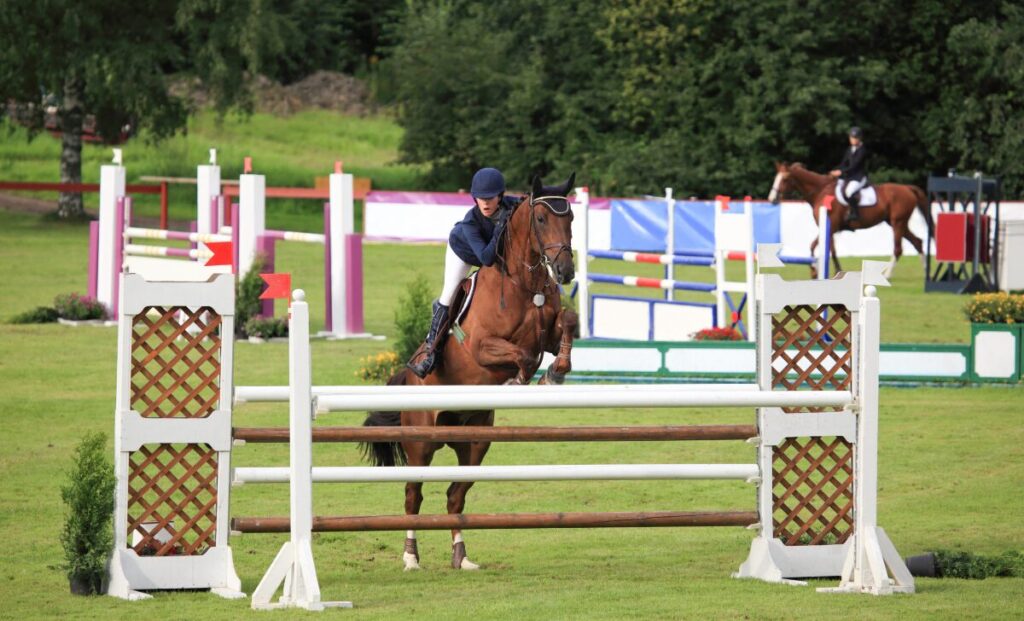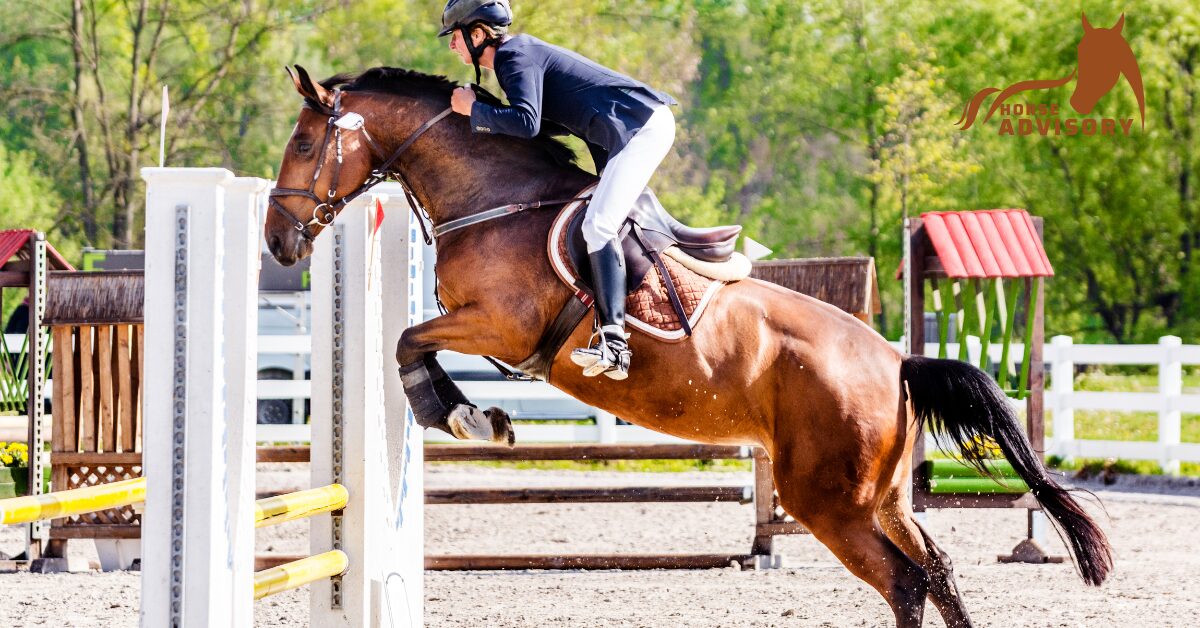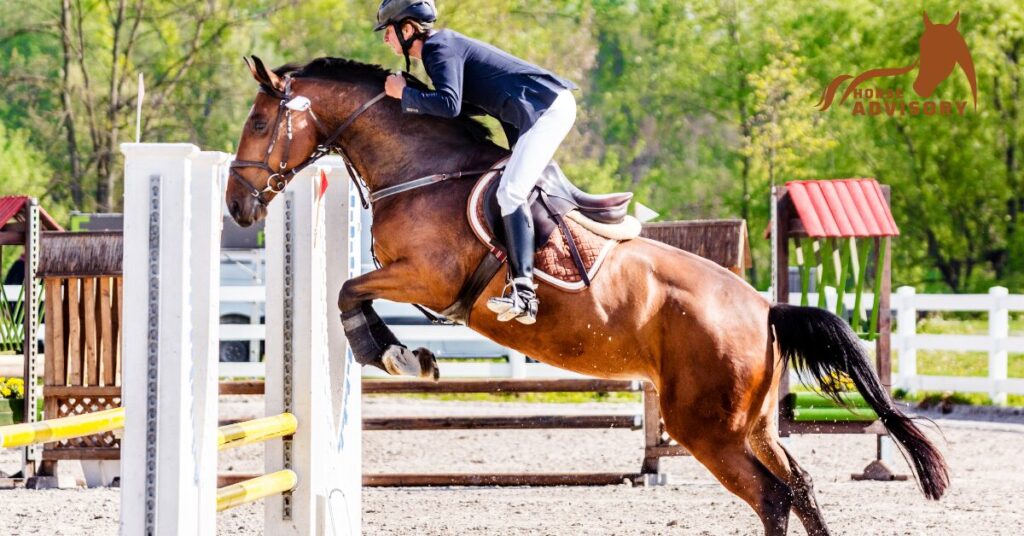Show jumping is a popular equestrian sport that tests both the horse and rider’s skill, agility, and partnership. The right horse breed can significantly impact a rider’s success in this challenging discipline.
Understanding What Makes a Good Show Jumping Horse
A successful show jumper needs a precise combination of traits. Agility, speed, power, and intelligence are all vital for navigating complex courses and clearing high jumps. Certain horse breeds naturally possess these traits, making them ideal contenders for show jumping. Here are some traits:
Agility and Speed
Agility is a crucial attribute for a show jumping horse. It determines how well the horse can maneuver around tight turns and quickly adjust its stride between fences. A horse with excellent agility can make quick, sharp turns and navigate through complex courses with ease. Similarly, speed plays a pivotal role in show jumping. The ability to accelerate swiftly and maintain a steady pace throughout the course allows the horse to clear jumps smoothly and within the required time limits. However, speed should not compromise control. A good show jumping horse knows when to speed up and when to slow down, demonstrating a perfect balance of speed and control.
Power and Intelligence
Power, or strength, is another key trait for show jumpers. It directly influences the horse’s ability to clear high jumps. A powerful horse can push off strongly from the ground, propelling both itself and the rider over the obstacle. But power alone isn’t enough; it must be coupled with intelligence. A successful show jumper needs to be smart, understanding commands quickly, and adapting to changing situations during a course. They need to judge distances accurately, know when to take off for a jump, and adjust their stride accordingly. This level of intelligence often comes from experience and training but is also inherent in certain breeds.
The Ideal Show Jumping Horse
Given these traits, the ideal show jumping horse is agile, fast, powerful, and intelligent. But beyond these physical and mental attributes, temperament also plays a significant role. The horse needs to be brave, as show jumping can involve intimidating obstacles. It should be calm under pressure and not get easily spooked by the crowd, other horses, or the bustling environment of a show. It’s also essential that the horse has a strong bond with its rider and a willingness to work together as a team. The best show jumping horses are those that combine all these traits, delivering performances that are not only successful but also a joy to watch.

Highlighting Preferred Horse Breeds for Show Jumping
Dutch Warmbloods
Originating from the Netherlands, Dutch Warmbloods are a prime example of selective breeding done right. This breed was developed by crossing local mares with foreign stallions, primarily from France and Germany. The result was a breed that combined the best traits of both – the strength and stamina of the native stock, and the elegance and athleticism of the foreign breeds. Today, Dutch Warmbloods are recognized worldwide for their prowess in equestrian sports, particularly show jumping.
The physical attributes of Dutch Warmbloods make them well-suited for show jumping. They are usually tall and muscular, with a long, straight back and strong hindquarters – ideal for the powerful leaps required in this sport. Their natural agility allows them to quickly adjust their stride and direction, making them nimble navigators of complex courses. But it’s not just their physical traits that set them apart; Dutch Warmbloods also possess an excellent work ethic. They are known for their willingness to work, their focus, and their ability to remain calm under pressure.
Beyond their physical abilities and work ethic, Dutch Warmbloods are also renowned for their level-headed temperament. They are generally calm, intelligent, and easy to train. This combination of physical prowess, work ethic, and temperament makes Dutch Warmbloods exceptional show jumpers. Their ability to remain composed, even in high-stress environments, is a valuable asset in the show jumping arena, where the atmosphere can often be intense.
Thoroughbreds
Thoroughbreds, known for their dominance in horse racing, also make exceptional show jumpers. Bred for speed and endurance, Thoroughbreds are one of the oldest recognized breeds, originating from three key Arabian stallions imported into England in the 17th and 18th centuries. Their lineage gives them not only their speed but also their distinctive, elegant appearance and spirited nature.
Thoroughbreds are naturally athletic and possess a keen sense of balance, both of which are critical for show jumping. Their muscular build, particularly their strong hindquarters, allows them to generate the power needed to clear jumps. Moreover, their quick reflexes enable them to respond swiftly to their rider’s commands and adjust their pace and direction as needed during a course. These physical traits, combined with their inherent speed and endurance, make Thoroughbreds highly capable in the show jumping arena.
However, it’s not just their physical capabilities that make Thoroughbreds popular show jumpers. They are also known for their intelligence and eagerness to please, which makes them highly trainable. Despite their reputation for being high-spirited, Thoroughbreds can also exhibit a calm, focused demeanor when properly trained and handled. This blend of speed, athleticism, and trainability makes Thoroughbreds a preferred choice among many show jumpers.
Irish Sport Horses
The Irish Sport Horse, also known as the Irish Hunter, is a result of strategic cross-breeding between the sturdy Irish Draught horses and swift Thoroughbreds. This breed is a testament to Ireland’s rich equestrian heritage and has gained international recognition for its versatility, strength, and agility in various equestrian disciplines, particularly show jumping.
Physically, an Irish Sport Horse typically stands about 15 to 17 hands high and can weigh over 600 kilograms. They are muscular with balanced proportions, embodying both the power of the Irish Draught and the agility of the Thoroughbred. This combination enables them to excel in demanding sports like eventing and show jumping.
Beyond their physical capabilities, Irish Sport Horses are also celebrated for their easy-going nature. They possess a tremendous gallop with plenty of speed and exceptional jumping talent. These horses have been bred for centuries to run, jump, and navigate across varied terrains, making them a reliable choice for competitive show jumping. Their cool temperament and trainable nature add to their appeal, allowing riders to form strong partnerships with these remarkable animals.
Hanoverians
Hanoverians originated from Germany and are a product of careful and selective breeding practices. This breed is characterized by its robustness and agility, traits that have contributed to its success in several equestrian disciplines, including show jumping.
Hanoverians display a keen willingness to work, which, when combined with their power and grace, makes them formidable competitors in the show jumping arena. Their strong build gives them the strength needed for powerful jumps, while their agility allows them to skillfully navigate complex courses.
Moreover, Hanoverians are known for their trainable nature. They are intelligent, quick to learn, and responsive to their rider’s commands. This makes them an excellent choice for show jumping, where effective communication between horse and rider is crucial for success.
These breeds’ unique attributes – the Irish Sport Horse’s blend of power and agility, and the Hanoverian’s robustness and eagerness to work – have led to their prominence in international show jumping competitions. Choosing a horse from these breeds could be a step towards finding a reliable and successful equine partner for show jumping.
Training a Show Jumping Horse
To train a show jumping horse, patience and consistency are key. Training should begin with basic flatwork to build the horse’s strength and flexibility. This includes exercises such as trotting poles and small jumps to improve coordination. It’s also important to work on the horse’s responsiveness to commands and to gradually introduce more complex exercises as the horse’s skills progress.
When training, it’s important to remember that each horse is unique and will learn and develop at its own pace. Regular training sessions, ideally daily, will help the horse to build muscle memory and become comfortable with the exercises. However, these sessions should not be overly long or strenuous, as this can lead to fatigue and injury.
Understanding Your Horse’s Capabilities
An understanding of your horse’s capabilities is crucial in show jumping training. This includes recognizing their strengths and weaknesses, as well as knowing when they are ready to progress to the next level of training. For instance, some horses may excel at speed, while others may have a natural ability for high jumps.
It’s also important to pay attention to your horse’s body language and behavior during training sessions. If a horse appears uncomfortable or resistant, it may be an indication that the exercise is too difficult or that the horse is experiencing pain or discomfort. In such cases, it might be necessary to adjust the training plan or consult with a vet.
Caring for a Show Jumping Horse
Proper care for a show jumping horse goes beyond training. A balanced diet is crucial for maintaining the horse’s health and energy levels. This generally includes high-quality hay, grains, and plenty of fresh water. Depending on the horse’s needs, dietary supplements may also be beneficial.
Regular exercise is another important aspect of care. This helps to keep the horse fit and prevents obesity, which can lead to various health issues. Exercise can include not only training sessions but also free time in a pasture where the horse can move around and socialize with other horses.
Routine vet check-ups are also essential. These will help to detect any health issues early and ensure that the horse is in peak condition for training and competitions. The vet can also provide advice on diet, exercise, and other aspects of care.
Conclusion
In conclusion, Dutch Warmbloods, Thoroughbreds, Irish Sport Horses, and Hanoverians have proven themselves as preferred breeds in the show jumping arena. When looking for a show jumping horse, considering these breeds might lead you to your perfect equine partner. However, remember that every horse is an individual, and success in show jumping comes not only from the breed but also from the connection between horse and rider, proper training, and care.





